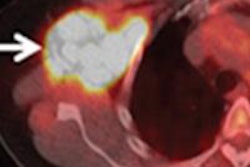That conclusion comes from researchers who are trying to develop novel imaging-based biomarkers for patients with the disease.
"Using these biomarkers, clinicians would be able to predict the overall survival and locoregional recurrence of NSCLC in patients treated with chemoradiation therapy," study presenter Dr. Ali Salavati, a radiology resident at the University of Minnesota, told AuntMinnie.com.
Salavati and colleagues cited growing evidence that supports the application of volumetric PET/CT parameters and partial-volume effect correction to predict outcomes in patients with non-small cell lung cancer.
Their study suggests that volumetric FDG-PET/CT parameters of the primary tumor could be "strong independent predictors of overall survival, which would bring us one step closer to optimized treatment plans for the NSCLC patients and clinically feasible personalized medicine," he added.
Among more than 150 patients, pretreatment metabolic tumor volume and total lesion glycolysis were independent predictors of overall survival, while maximum standardized uptake value (SUVmax) and partial-volume effect correction SUVmax were not good prognosticators.
"By using these data, we can develop a metabolic staging method which might be more precise compared to the conventional staging techniques, which will lead us to the most accurate treatment plan for the patient," he said.
Salavati and colleagues plan to assess the value of volumetric FDG-PET/CT parameters in other oncologic applications, such as head and neck and esophageal cancers, in various national databases.



















